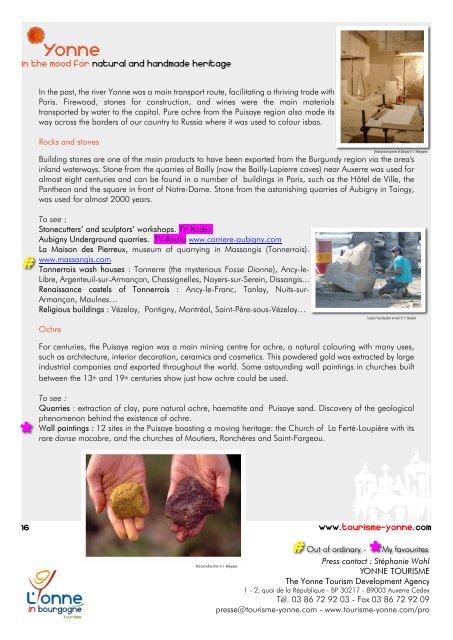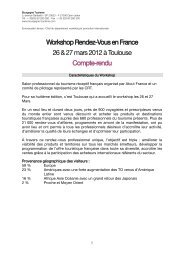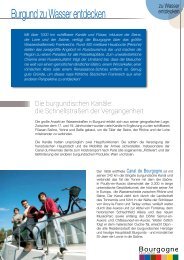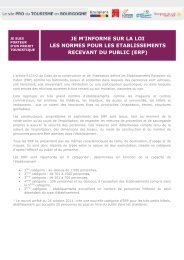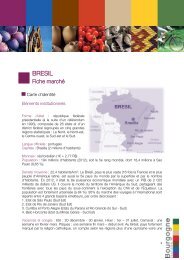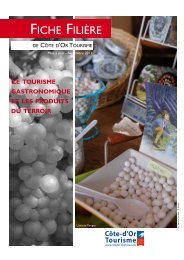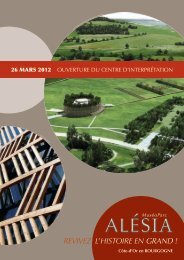Bourgogne tourisme
Bourgogne tourisme
Bourgogne tourisme
You also want an ePaper? Increase the reach of your titles
YUMPU automatically turns print PDFs into web optimized ePapers that Google loves.
Yonne<br />
In the mood for natural and handmade heritage<br />
In the past, the river Yonne was a main transport route, facilitating a thriving trade with<br />
Paris. Firewood, stones for construction, and wines were the main materials<br />
transported by water to the capital. Pure ochre from the Puisaye region also made its<br />
way across the borders of our country to Russia where it was used to colour isbas.<br />
Underground quarries of Aubigny© J. Kélagopian<br />
Building stones are one of the main products to have been exported from the Burgundy region via the area's<br />
inland waterways. Stone from the quarries of Bailly (now the Bailly-Lapierre caves) near Auxerre was used for<br />
almost eight centuries and can be found in a number of buildings in Paris, such as the Hôtel de Ville, the<br />
Pantheon and the square in front of Notre-Dame. Stone from the astonishing quarries of Aubigny in Taingy,<br />
was used for almost 2000 years.<br />
To see :<br />
TV-Radio<br />
TV-Radio www.carriere-aubigny.com<br />
museum of quarrying in Massangis (Tonnerrois).<br />
www.massangis.com<br />
: Tonnerre (the mysterious Fosse Dionne), Ancy-le-<br />
Libre, Argenteuil-sur-Armançon, Chassignelles, Noyers-sur-Serein, Dissangis...<br />
: Ancy-le-Franc, Tanlay, Nuits-sur-<br />
Armançon, Maulnes…<br />
: Vézelay, Pontigny, Montréal, Saint-Père-sous-Vézelay…<br />
Sculptor Yvan Baudoin at work © Y. Baudoin<br />
For centuries, the Puisaye region was a main mining centre for ochre, a natural colouring with many uses,<br />
such as architecture, interior decoration, ceramics and cosmetics. This powdered gold was extracted by large<br />
industrial companies and exported throughout the world. Some astounding wall paintings in churches built<br />
between the 13 th and 19 th centuries show just how ochre could be used.<br />
To see :<br />
: extraction of clay, pure natural ochre, haematite and Puisaye sand. Discovery of the geological<br />
phenomenon behind the existence of ochre.<br />
12 sites in the Puisaye boasting a moving heritage: the Church of La Ferté-Loupière with its<br />
rare danse macabre, and the churches of Moutiers, Ronchères and Saint-Fargeau.<br />
Out of ordinary -<br />
My favourites<br />
Red and yellow ochre © J. Kélagopian<br />
1 - 2, quai de la République - BP 30217 - 89003 Auxerre Cedex<br />
Tél. 03 86 72 92 03 - Fax 03 86 72 92 09<br />
presse@<strong>tourisme</strong>-yonne.com - www.<strong>tourisme</strong>-yonne.com/pro


